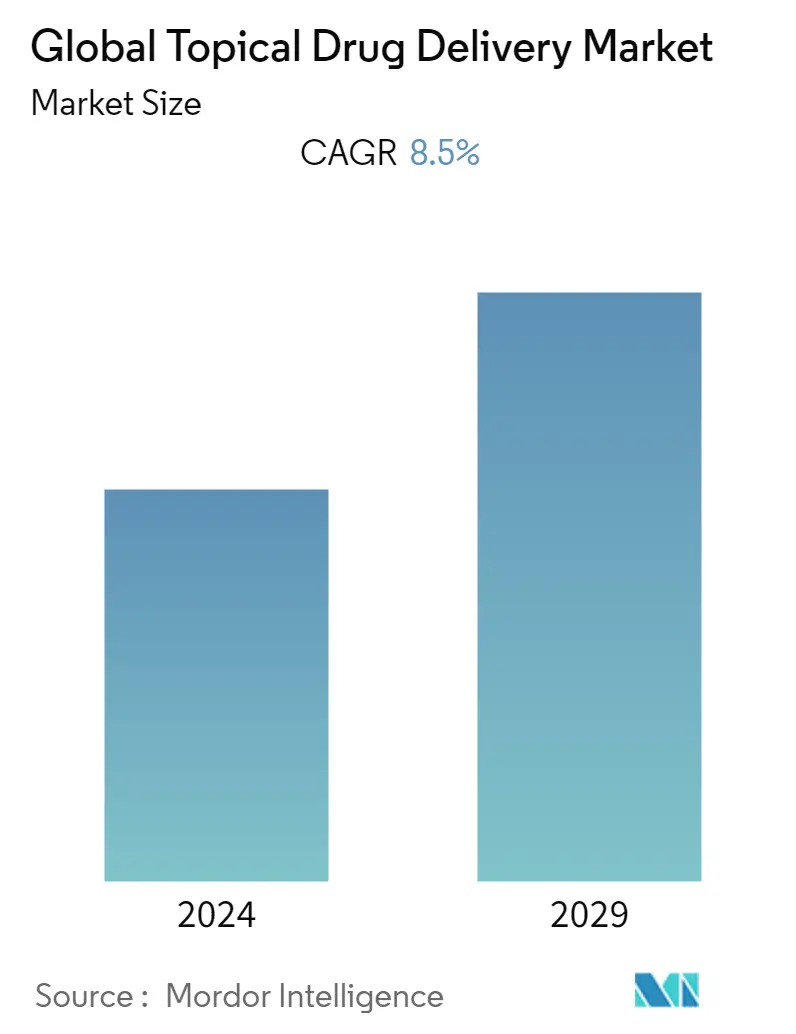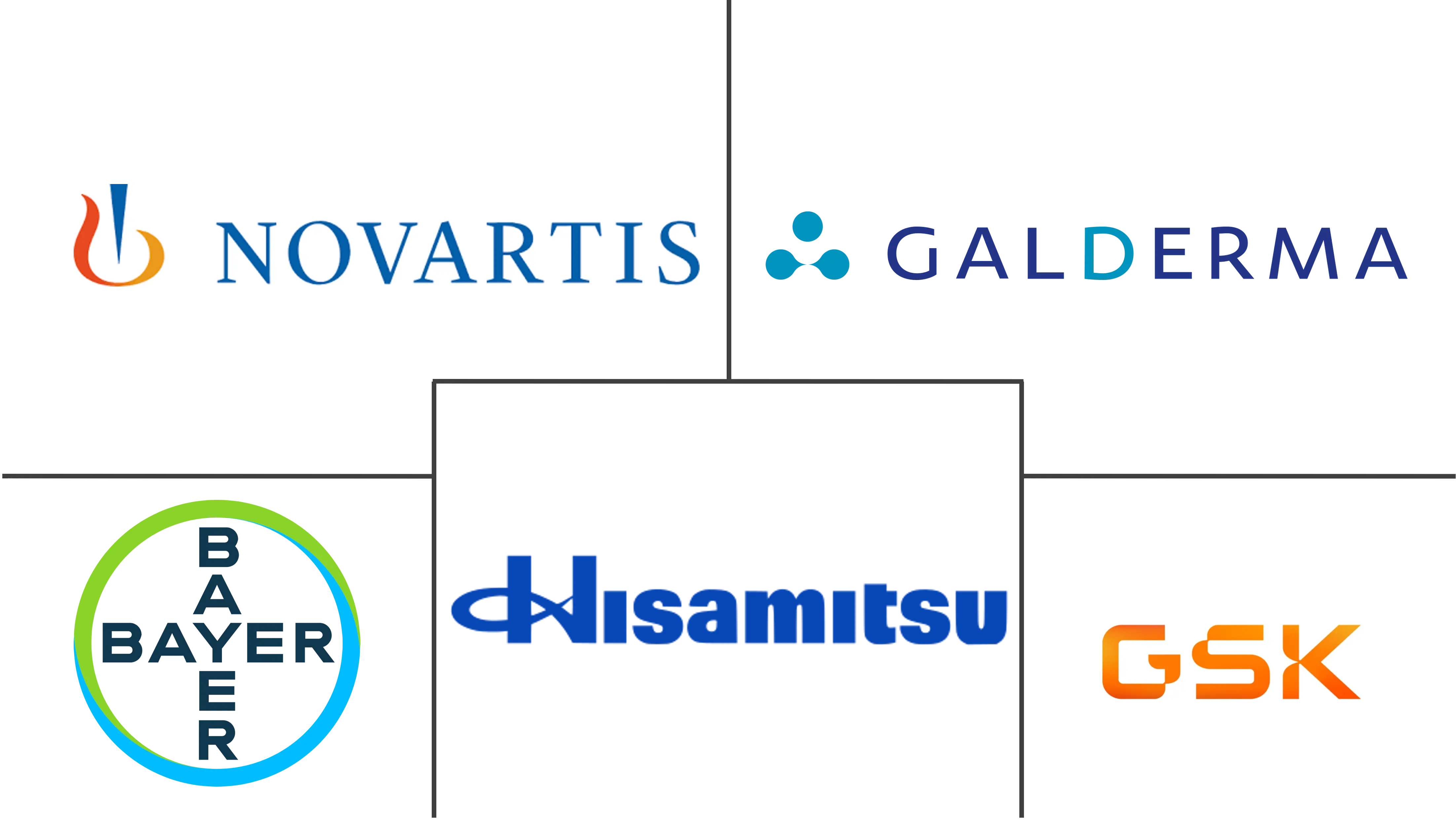Market Size of Global Topical Drug Delivery Industry

| Study Period | 2019 - 2029 |
| Base Year For Estimation | 2023 |
| Forecast Data Period | 2024 - 2029 |
| CAGR | 8.50 % |
| Fastest Growing Market | Asia Pacific |
| Largest Market | North America |
Major Players
*Disclaimer: Major Players sorted in no particular order |
Need a report that reflects how COVID-19 has impacted this market and its growth?
Topical Drug Delivery Market Analysis
The Topical Drug Delivery Market is expected to witness a CAGR of 8.5% during the forecast period (2022 - 2027).
The COVID-19 pandemic has posed serious challenges to healthcare systems in Europe and has largely been controlled by drastically cutting down in- and outpatient services for diseases and implementing infection prevention and control measures. The lockdown all over the globe has affected the supply chain of drugs and products. The pandemic has significantly impacted the growth of the topical drug delivery market due to the pandemic situation and restrictions, healthcare settings such as hospitals and specialty clinics were temporary. For instance, an article published by the Dermatological Practical and Conceptual, in January 2021, titled 'Impact of the COVID-19 Pandemic on Dermatology Practice Worldwide: Results of a Survey Promoted by the International Dermoscopy Society (IDS)', it has been observed that the outbreak had a detrimental impact on the majority of dermatology services, leading to a considerable decrease in the amount of time spent consulting with patients and a higher likelihood of missed or delayed diagnoses of skin diseases. Thus, the decreased consulting time spent with patients resulted in a significant drop in patient visits, which has impacted the demand for treatment and services and has negatively impacted the market growth.
However, due to several disadvantages, such as discomfort and needle phobia, the requirement for two doses, the need for trained medical professionals to administer the vaccine, and barriers to international distribution due to the requirement for a cold supply chain, the demand for the transdermal delivery has increased. For instance, according to an article published by SAGE Journal, in August 2021, titled 'Transdermal approaches to vaccinations in the COVID-19 pandemic era', the potential of transdermal approaches, such as microneedle (MN) patches, as an alternative modality for painless medication delivery in COVID-19, has recently been explored. In addition, it has been observed that the successful development of microneedle (MN) patch vaccines has a substantial impact on future vaccine delivery and the decrease of the COVID-19 disease burden. Thus, the increasing clinical studies for topical delivery of vaccines in COVID-19 are expected to increase the market growth over the forecast period.
Certain factors that are propelling the market growth are the high prevalence of skin diseases and technological advancements and innovations.
The rising prevalence of skin diseases such as eczema, psoriasis, acne, cold sore, hives, eczema, and others are the key factors driving the market growth. For instance, according to an article published by StatPearls, in August 2021, titled 'Eczema', it has been observed that the lifetime prevalence of eczema in children is between 15-30% and 2-10% in adults. In addition, as per the same source, about 50% of the patients with severe atopic dermatitis are likely to develop asthma and 75% are likely to develop allergic rhinitis. Additionally, an article published by the Journal of the European Academy of Dermatology and Venerology, in February 2022, titled 'Incidence, prevalence, and risk of acne in adolescent and adult patients with atopic dermatitis: a matched cohort study', it has been observed that in both the general population and atopic dermatitis patients, the 12-month prevalence of acne was 3.7% and 3.9%, respectively. Also, the highest incidence rate of acne was found in atopic dermatitis patients aged 12-18 years, and women with atopic dermatitis had a somewhat greater incidence of acne than men. Furthermore, as per the same source, in comparison to controls, the risk ratio for acne rose with age, reaching 1.41 for patients between the ages of 30 and 39 and 2.07 for patients above the age of 40. Thus, the rising burden of skin diseases among the population is expected to increase the demand for effective and better treatment options which in turn is expected to increase the demand for topical agents, thereby boosting the market growth.
Additionally, the rising technological advancements and innovations are also contributing to market growth. For instance, in March 2022, Galderma launched Twyneo (fixed-dose combination of tretinoin 0.1% and benzoyl peroxide 3%) cream for the topical treatment of acne vulgaris in patients 9 years of age and older. Also, in December 2020, the United States Food and Drug Administration approved Almirall's Klisyri (tirbanibulin) for the topical treatment of actinic keratosis (AK) of the face or scalp.
However, the regulatory scenarios and pricing pressure, and high frequency of product recalls are some factors that are hindering the market growth over the forecast period.
